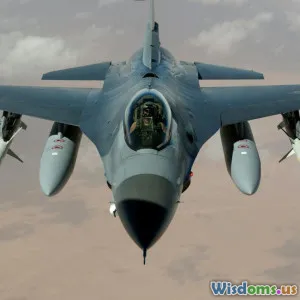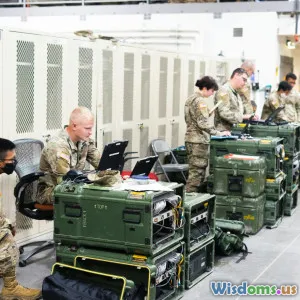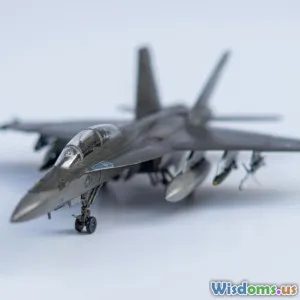
How Hypersonic Missiles Challenge Existing Defense Networks
10 min read Explore how hypersonic missiles disrupt current defense systems and the innovations driving countermeasures. (0 Reviews)
How Hypersonic Missiles Challenge Existing Defense Networks
Introduction
Imagine a missile so fast and maneuverable that existing defense systems struggle to detect, track, or intercept it. Hypersonic missiles—traveling at speeds greater than Mach 5 (over 3,800 miles per hour)—are transforming modern warfare and challenging the defensive frameworks nations currently rely on. They combine speed, altitude, and maneuverability in ways that bypass traditional missile defense shields, signaling a paradigm shift in strategic military capabilities.
This article explores why hypersonic missiles represent a game-changing threat, examines the shortcomings of existing defense networks, and outlines the innovations countries are pursuing to respond to this new era of military technology.
The Rise of Hypersonic Missiles: Speed with Maneuverability
Technical Definition and Capabilities
Hypersonic missiles fall under two main categories: Hypersonic Glide Vehicles (HGVs) and Hypersonic Cruise Missiles (HCMs).
-
Hypersonic Glide Vehicles are launched atop ballistic missiles and glide through the upper atmosphere at sustained hypersonic speeds. Thanks to their ability to perform unpredictable maneuvers right before reaching their targets, HGVs can evade radar tracking and interception.
-
Hypersonic Cruise Missiles utilize air-breathing engines, such as scramjets, to maintain these extreme speeds over considerable distances while flying at lower altitudes.
The combination of high velocity, maneuverability, and low flight trajectories makes these weapons difficult to detect and challenging for traditional defense systems to counter. For context, a hypersonic missile traveling at Mach 5 covers more than one mile in just one second.
Global Developments
Leading military powers like the United States, Russia, and China have heavily invested in hypersonic missile development:
-
Russia’s Avangard HGV reportedly reaches speeds of up to Mach 27 and entered service in recent years, making it one of the fastest missile systems known.
-
China’s DF-17 missile system integrates an HGV designed for rapid strikes against regional targets.
-
The United States’ AGM-183A Air-launched Rapid Response Weapon (ARRW) represents ongoing efforts to develop hypersonic air-launched missiles.
These developments illustrate a global arms race accelerating under the awareness that hypersonics could undermine traditional deterrence strategies.
Limitations of Traditional Defense Networks
Radar and Early Warning Systems
Existing missile defense systems rely on radar and satellite sensors to detect, track, and predict the trajectory of incoming threats. However, hypersonic weapons exploit several vulnerabilities:
-
Low-Altitude Flight Paths: HGVs and HCMs can fly at altitudes lower than traditional ballistic missiles, remaining below or just at the edge of radar horizons, thus delaying detection.
-
Maneuverability: Highly unpredictable flight maneuvers confound trajectory prediction algorithms, which are essential for guiding interceptors.
-
Speed: Their extremely high velocity shrinks response time to minutes—or even seconds—compared to current missile defense response windows.
For example, current U.S. Ground-based Midcourse Defense systems, optimized for ballistic trajectories, struggle to adapt to these new flight profiles, limiting their effectiveness.
Interceptor Missile and Defense System Challenges
Intercepting hypersonic missiles requires highly precise and agile interceptor systems:
-
Kill Vehicle Guidance: Traditional interceptors rely on calculated intercept points derived from steady missile trajectories. The oscillatory flight paths of hypersonic vehicles require interceptor systems to be far more adaptable.
-
Reaction Time: Less time to launch interceptors necessitates faster decision-making, preemptive launches, and real-time tracking capabilities.
-
Thermal and Aerodynamic Constraints: Hypersonic speeds generate extreme heat, causing plasma sheath formation around the missile and complicating radar and infrared tracking.
The short duration between detection and arrival severely limits strategic options, forcing defense networks to rethink missile engagement sequences.
Strategic Implications: New Threats and Shifting Doctrines
Deterrence and Escalation Dynamics
Hypersonic missiles can neutralize or undermine traditional deterrents, such as early-warning systems and missile defense shields, by ensuring the survivability of offensive payloads.
-
Surprise and Precision Strike: Nations could potentially launch precision strikes with minimal warning, making strategic retaliation difficult and increasing the likelihood of escalation.
-
Ambiguous Attribution: Their maneuverability and speed complicate tracking, leading to difficulties in determining origin or intent quickly and accurately.
As former U.S. Vice President Joe Biden noted, "The development of hypersonic weapons is blurring the lines of strategic stability, forcing us to rethink our defense priorities."
Challenges for International Arms Control
Hypersonic missiles pose new challenges for arms regulation and treaty enforcement because:
-
Their dual-use propulsion technologies overlap with civilian aerospace advancements.
-
Existing arms control frameworks did not anticipate such systems, leaving gaps in verification mechanisms.
-
Speed and maneuverability complicate transparency and early detection, risking misinterpretation and accidental escalation.
Efforts under frameworks like the New START treaty are evolving but remain insufficient to address hypersonics fully.
Emerging Defense Approaches to Hypersonic Threats
Enhanced Detection Technologies
To address detection challenges, countries are investing in:
-
Over-the-Horizon Radars: These systems can detect low-altitude, fast-moving threats beyond the horizon location.
-
Space-Based Sensors: Constellations of satellites equipped with infrared and radar sensors offer persistent global coverage, enabling earlier hypersonic missile detection.
-
Multispectral Tracking: Combining radar, infrared, and optical sensors improves object characterization and tracking accuracy.
Advanced Interceptors and Directed Energy Weapons
Defense innovation is focusing on countering hypersonics through:
-
Kinetic Kill Vehicles (KKVs): Improved KKVs with high agility and autonomous tracking for engaging maneuvering targets.
-
Directed Energy Weapons (DEWs): High-energy lasers can engage missiles at near-light speeds, providing rapid, reliable interception opportunities in the boost and terminal phase.
-
Electronic Warfare: Disrupting missile guidance systems through jamming and spoofing could degrade missile accuracy.
Integrated Defense Networks and AI
Developing sophisticated command and control architectures is critical:
-
Artificial Intelligence: Machine learning algorithms enhance real-time threat assessment, decision-making, and interceptor control, reducing human decision latency.
-
Networked Sensors and Weapons: Cross-linking satellites, radars, and interceptors provides a holistic, coordinated defense strategy adaptable to hypersonic flight profiles.
The U.S. Air Force’s Hypersonic and Ballistic Tracking Space Sensor (HBTSS) program exemplifies this integrated approach.
Real-World Examples Demonstrating the Challenge
-
In 2019, China successfully tested its DF-17 hypersonic missile, raising concerns worldwide about vulnerabilities in American missile defense architecture.
-
Russia’s Avangard system reportedly passed operational tests by successfully evading U.S. missile interceptors during trials.
These developments validate concerns over existing defense capabilities and underline the imperative for accelerated counter-hypersonic innovations.
Conclusion
Hypersonic missiles represent a disruptive leap in military technology by combining unprecedented speed and maneuverability, rendering many traditional defense systems obsolete. Their ability to evade detection, shrink engagement windows, and challenge interception techniques signals a transformative threat with profound strategic implications.
To maintain national security and global stability, defense networks must evolve through enhanced sensor technologies, advanced interceptor systems, integrated command frameworks, and international collaboration on arms control.
Understanding this emerging threat empowers policymakers, scientists, and defense strategists to innovate solutions that preserve deterrence and safeguard peace in an increasingly complex security environment.
As the hyperspeed arms race accelerates, staying ahead demands vigilance, investment, and global cooperation to ensure defense networks can meet the hypersonic challenge.
References
- Department of Defense Hypersonic Weapons Strategy Document, 2022.
- Federation of American Scientists: Hypersonic Weapons Overview.
- NASA Scramjet Development Reports.
- Interviews with Dr. Heather Williams, Missile Defense Expert, 2023.
- SIPRI Yearbook 2023: Global Arms Developments.
Article by [AI Content Generator]
Rate the Post
User Reviews
Popular Posts



















